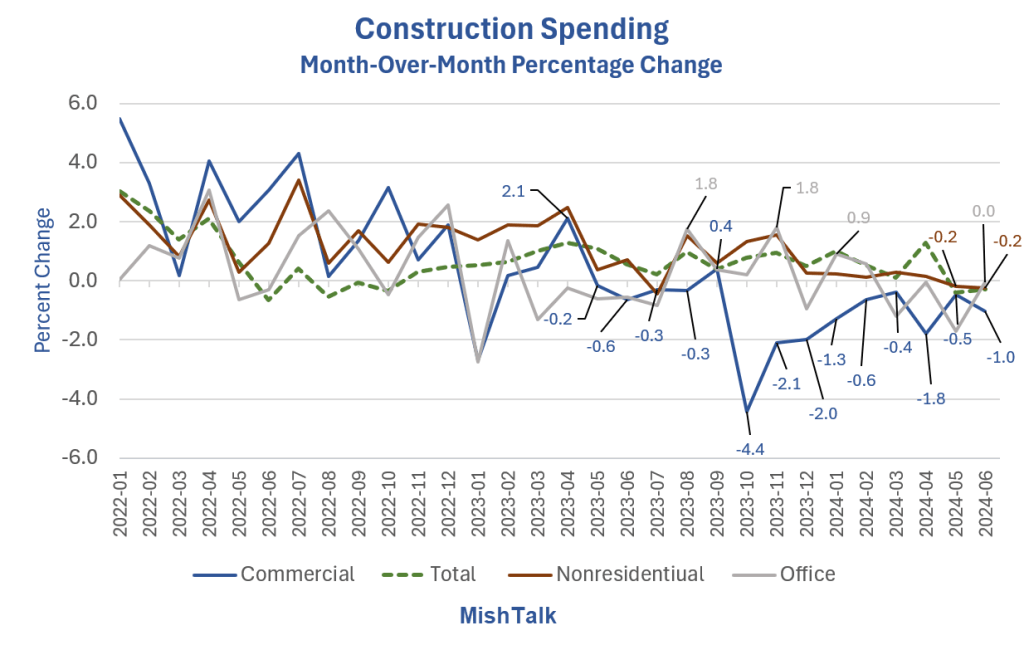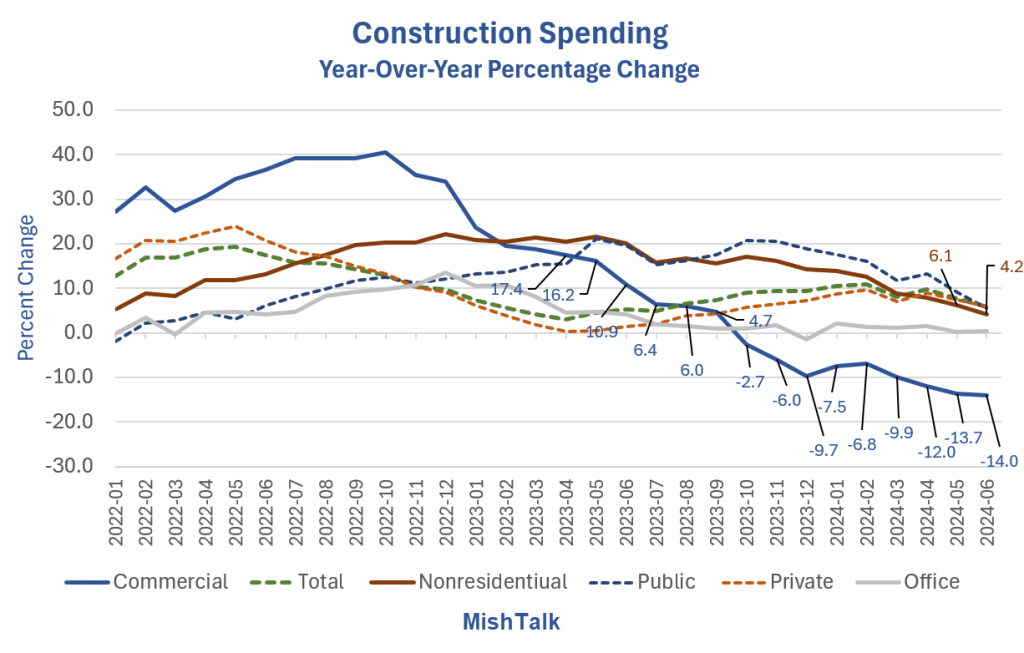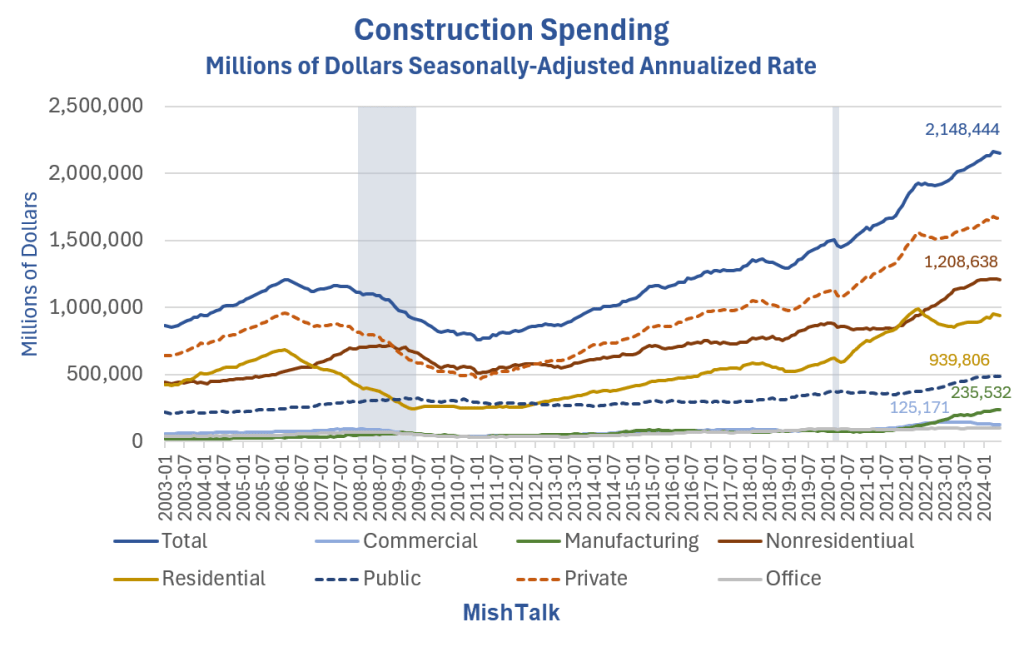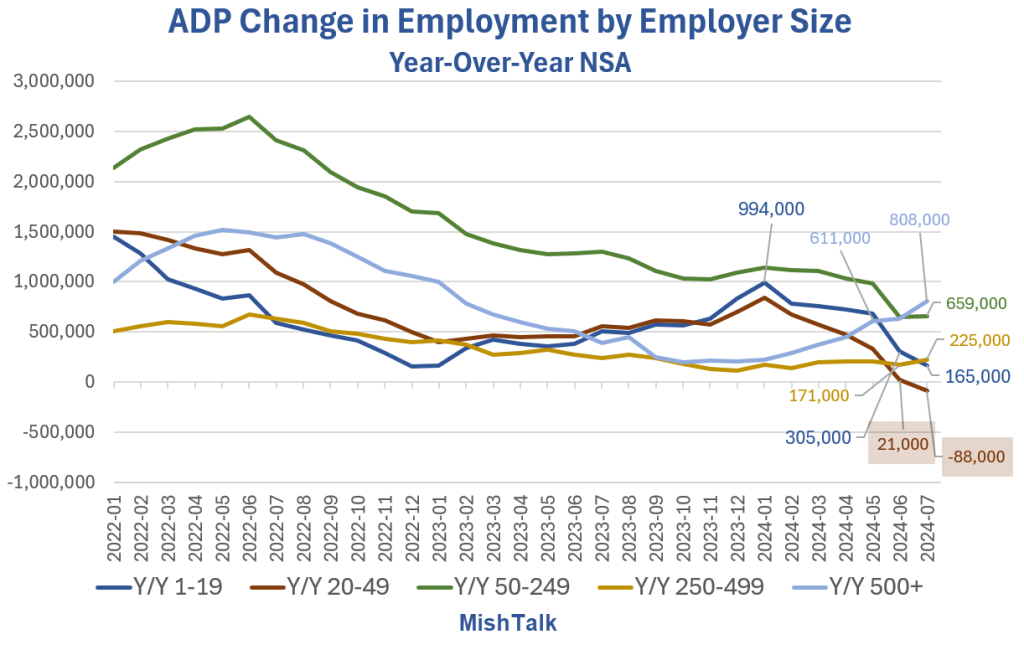Here’s the kicker: It’s not office related. And the Census Department has heavy negative revisions to spending. Let’s investigate.

Construction spending reports are so horribly lagging that I stopped commenting on the for a while.
But interesting trends are underway. Also, these late reports will influence GDP revisions.
So I created some new chart this month to show what’s going on.
Negative Revisions
The June Construction Spending report was a disaster.
The Bloomberg Econoday consensus was for a rise of 0.2 percent.
Instead, the Census Department reported a decline of 0.3 percent and it revised May from -0.1 percent to -0.4 percent.
Economists effectively missed the mark by 0.8 percentage points to the downside.
Commercial Construction Spending
Commercial construction spending was down 9 consecutive months.
I thought this might be office spending related, but office spending was up in three of those months and flat in a fourth. Edit: Office and commercial are part of nonresidential, but office is not part of commercial.
Year-Over-Year Spending

Year-over-year spending is still positive except for commercial, but everything is downward sloping.
Year-over-year commercial construction spending went negative in October of 2023 and has stayed there ever since, generally declining.
It’s now down 14.0 percent year-over-year.
Construction Spending Millions of Dollars

Every key component of construction has peaked and is rolling over except for manufacturing.
The latter is due to misguided attempts by the auto industry to roll out EVs and more importantly free money from the Biden administration for autos, chip manufacturing, solar manufacturing, etc.
Commercial Construction Categories
The Census Department has a nice breakdown of Construction Spending Categories.
In general, commercial Includes buildings and structures used by the retail, wholesale and selected service industries.
Offices are part of nonresidential construction as is commercial. But offices are not part of commercial.
Here’s a spotlight on commercial construction.
- Auto: includes auto dealerships, motorcycle dealerships, auto showrooms, and truck dealerships.
- Food: includes supermarkets, bakeries, dairies, markets, convenience stores, and delicatessens.
- Dining/drinking: includes liquor stores, bars, nightclubs, cafés, diners, restaurants, cafeterias, taverns, inns (eat & drink only), and bistros.
- Fast food: includes drive-in restaurants and fast food restaurants.
- Multi-retail: includes department stores and variety stores, shopping centers, shopping plazas, and town centers.
- Other commercial: includes drug stores and pharmacies, hardware stores and lumber yards, clothing stores, jewelry stores, salesrooms (non-auto), furniture stores, office supply stores, storerooms, and electronics stores.
Commercial Construction a Driver of Job Growth
Commercial construction is only $125.171 billion compared to $939.806 billion residential, $483,850 public, and $2.148 trillion total.
However, once houses and roads are built, there are no further directly related jobs. Once stores are built, there are many directly related jobs.
Commercial construction is a tiny component of construction spending but a mighty contributor to future jobs once completed.
The Manufacturing ISM Index Disaster
Despite the boom in manufacturing spending, the July Manufacturing ISM Index Is Lower Than Every Economist’s Estimate
The ISM manufacturing report was a disaster from every angle, especially employment , production, and backlogs. Employment reading worst since June 2020.
Please read what some of the respondents are saying. It a disaster in every industry.
Small Business Employment Growth Is Now Negative

Yesterday, I commented Small Business Employment Growth Is Now Negative (and What It Means)
ADP data shows year-over-year payroll growth is negative 88,000 for small corporations sized 20-49. Trends are negative in all but very large corporations.
On July 26, I commented Expect the BLS to Revise Job Growth Down by 730,000 in 2023, More This Year
At the heart of these revisions is a horribly flawed birth-death model used by the BLS. My calculation closely matches an estimate by Bloomberg’s chief Economist.
In addition to the birth-death model, or perhaps explaining the birth-death model errors, small business employment is declining fast.
Looking Ahead
If businesses are not expanding stores and restaurants, then they won’t be hiring to staff those stores and restaurants either.
“All Hell Breaks Loose” In the Next Few Months as Recession Bites
On July 25, I commented “All Hell Breaks Loose” In the Next Few Months as Recession Bites
Two of us are still adamant that a recession has started. The other is Danielle DiMartino Booth, in her best video yet.
Please take a look.
Correction: I labeled the spending chart as billions. It should say million.
